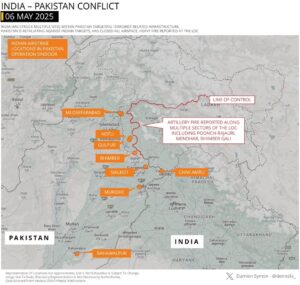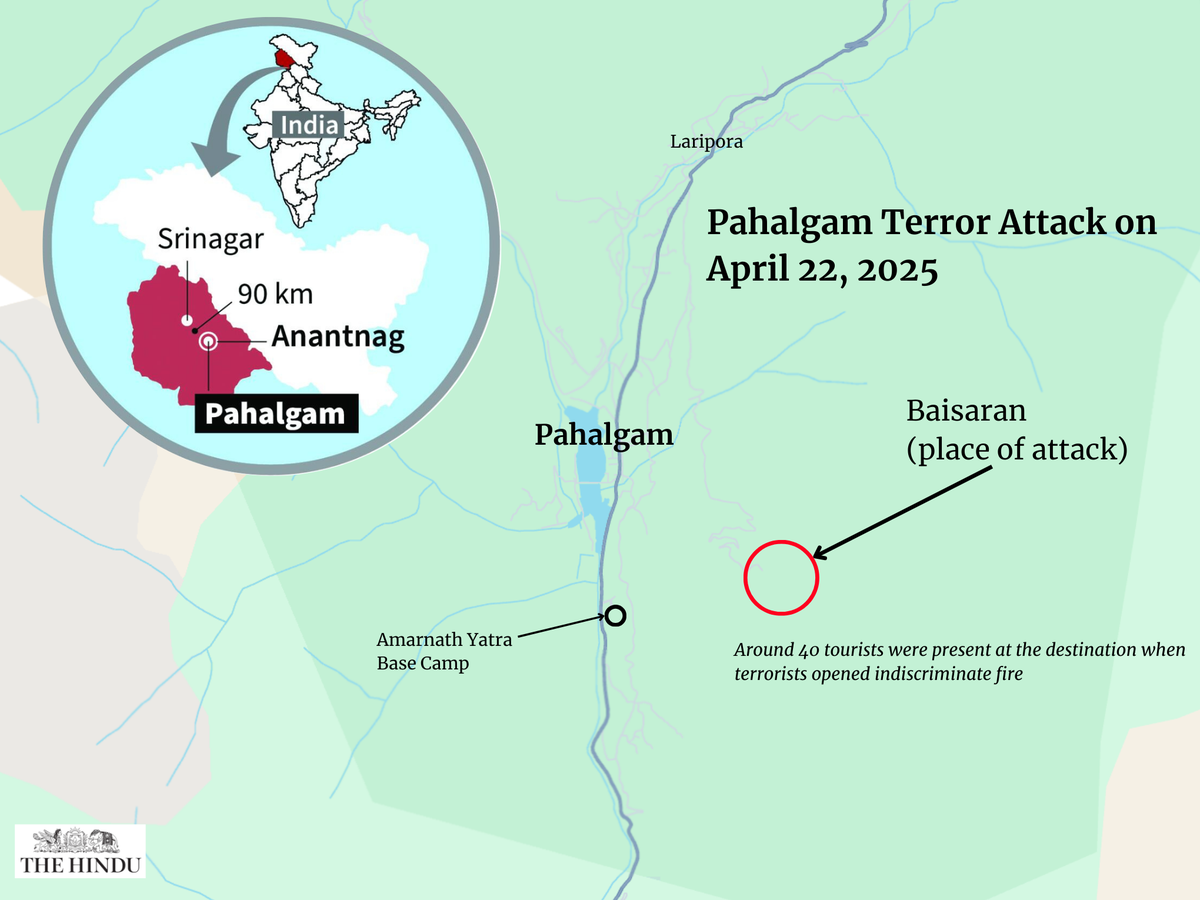A Geopolitical Analysis of Kashmir Part 3: The Silent Winners in the India-Pakistan 2025 Dispute – Defense Corporations
India and Pakistan agreed to a ceasefire on May 10, 2025, although tensions remain following the recent military escalation. Both claim a strategic victory over the other, and this article explores some of the real winners. On 22 April 2025, 26 civilians were killed in a terrorist attack in Pahalgam, a tourist resort within Indian administered Jammu and Kashmir. Over the following weeks, India reduced diplomatic ties with Pakistan, cancelled visa applications and processing, limited travel to Pakistan, banned trade to Pakistan, and suspended the Indus Water Treaty. The military from both India and Pakistan flexed their muscles by conducting missile drills and restricting airspace movement. On May 7, based on credible intelligence of where the terrorists were planning and housed, Prime Minister Modi ordered operation Sindhoor, targeting nine sites across Pakistan-administered Kashmir and Punjab[1]. Although none of the sites were military facilities or civilian centres,31 civilians were reported to be killed. Pakistan retaliated during the same evening and later claimed to have successfully shot down several Indian fighter jets and drones. Shortly thereafter, both militaries exchanged fire across the Line of Control (LoC), the arbitrary line created by the British before leaving the subcontinent, firing missiles, launching several drone strikes, targeting each other’s air defence systems and military zones, as civilian casualties slowly mounted. As events transpired, many global nations advocated for maximum restraint. Following efforts from the US as a mediator, India and Pakistan entered an uneasy truce.[2]

During this military dispute, modern military equipment such as drones was used in targeted strikes. A military’s air force offers air superiority through strategic bombing and targeting, deployment of troops, logistics and disrupting opposing operations. As a result, air superiority is a significant aspect in any conflict.[3] Drones guarantee enhanced reconnaissance and precision-targeting possibilities. These unmanned aerial vehicles (UAVs) could be less expensive than aeroplanes, depending on their design, and more importantly, reduce the risk of loss of life of soldiers in combat scenarios.[4] According to Christopher Clary, the 2025 battle signalled a change in thresholds, with Pakistan using ballistic missiles and drones in response to India’s use of cruise missiles, pointing to a new stage of conventional deterrence under the nuclear umbrella. Missiles offer long-range targeting and deterrence for enemy activity. Depending on the missile, they could be intercontinental ballistic missiles capable of far-reaching and carrying nuclear-capable weapons, cruise missiles and hypersonic missiles.[5] Throughout the dispute, these three military elements received various results.

During Operation Sindoor, the Indian Air Force reportedly used BrahMos supersonic cruise missiles on Pakistani military air bases, damaging infrastructure and impacting Pakistani air capabilities.[6] These missiles marked a breakthrough for the rising Indian defence complex. This missile, initially developed between India and Russia, has been increasingly domestically developed by organisations such as BrahMos Aerospace Limited and distributed for use across the Indian Armed Forces. Following the recent success, India and Russia are in talks to further advance the missiles’ capabilities and scale up production.This will allow India to reduce their dependency on foreign military imports, for which they are the second highest globally. Hence, national political movements such as Make in India would receive a noteworthy boost following this example as a success.
While India’s missile systems reach a turning point, the air force received the opposite. India had reportedly used its Air Force during the initial first strike on nine terrorist targets in Pakistan. However, Pakistan recounted in the aftermath they had successfully shot down five fighter jets and drones.[8] While unconfirmed on any losses or number of jets, social media began trending on certain wreckages of apparent parts of military jets found within India. Specifically, some photos revealing pieces of the recently purchased French-manufactured Indian Rafale fighter jet, which was later confirmed by French Intelligence that at least one Indian Rafale was lost.[9] This poses a major blow to India’s morale and applause for Pakistan’s confidence in the skies. The financial impact for current and future spending improving India’s air force capabilities will be reviewed. Dassault Aviation, the Rafale fighter jets, immediately felt the consequences with a drop in share prices.[10] Although current stocks are high, future Dassault projects face potential jeopardy, such as the 8.1-billion US dollar deal for 42 Rafale jets by the Government of Indonesia. Initially picked for advanced weaponry and capabilities, Pakistan’s claims of downing 3 Rafales using their Chinese made J-10C fighters equipped with advanced PL-15 air-to-air missiles, has led to critical debates about the substantial investment given the plane’s recent combat performance.[11] As a result, China’s defense stocks have advanced indicating rising profits and opportunities following Pakistan’s announcement during the dispute.[12]

A new chapter commenced with this dispute, with the first drone conflict between nuclear powers, and it kick-started a new phase for both states.[13] Both states claimed to successfully meet both their tactical and operational objectives through the usage of missiles, air and drones. India’s airstrikes and usage of drone warfare demonstrated their efficiency, as Dr Cheema, a strategic analyst, stated that vulnerabilities are present in Pakistan’s defence.[14] Thus, arguing that Pakistan will need to invest further in drone defences, as their armed forces acknowledged damage received at their Bholari airbase.[15] Yet Pakistani forces claimed they shot down 25 drones across various cities, which were reportedly Harop drones, manufactured by Israel. Pakistan has a capable inventory of both domestic and imported drone systems. Thus, indicating both countries realise the potential drones provide in modern warfare. This recent clash marks a new arms race to acquire the technologically advanced systems to conduct decoy or swarm operations, suppress enemy movement or bases, and act as high-altitude surveillance with deadly triggers.[16] India plans to invest approximately 470 million on UAVs,[17] whereas Pakistan reportedly has ordered 30 Wing Loong UAVs from China.[18] These investments reflect a developing military doctrine. India established an integrated air defence system, including drones, protecting military and civilian assets, and reportedly repelling multiple large-scale drone attacks from Pakistan. However, Pakistan’s military will learn from the drone’s results of the conflict and expand their intelligence surveillance and defensive drones to improve their capabilities[19]. More importantly, defence companies had a key insight into factors which will determine the future of drone warfare in South Asia, as they receive future orders from either the military on what aspects to improve, modify or incorporate in new drone designs and technology. There were key lessons to be learnt by both sides during this conflict in the air and with drones. Whilst analysts agree India has the stronger position in numbers and capabilities, Pakistan still can inflict considerable damage should a conflict escalate, something neither country can afford in the long term.[20]
Another key factor was the use of language. With both claiming victory and downplaying military losses, this remains a calculated effort to boost public morale on both sides. Despite these descriptions, there are still unanswered questions from this conflict on both sides. What was the actual number of planes lost by India? What was the extent of the damage to Pakistan’s airbases? How credible was the intelligence on the terrorist locations? What new or modified financial amount is to be invested in future military technology by either state? In addition, language usage influences key actors in the defence sector, policy makers across government parties, whether reinforcing a vote of confidence to invest with the same international or local defence companies or thoroughly inquire into why such expensive military investments failed to deliver necessary results. Both states emphasised just and measured responses and used accusatory terms, placing the blame on the other. Reports and media received mixed responses from governments around the globe, mostly condemning the terrorist attack and appealing for restraint during the escalation.
There are countries and defence companies in the backdrop who have benefited from this. Several mentioned previously have acquired a key feature of weaponry and military equipment, the title ‘battle-tested’. There are plenty of examples when a gun, artillery, drone or airplane has malfunctions or is not efficient when used. On the battlefield, whether in Ukraine, Afghanistan, Congo or Kashmir, wherever the military assets were deployed and used, complications can arise. The feedback provided by the users becomes a goldmine of knowledge for the manufacturers. The defence companies that manufacture this equipment can apply the improvements they need. That way, when these military assets are sold to other countries and armed forces, they are assured that these are more capable than something labelled as new and untested. These can be sold at higher prices and increase demand, enhancing company profits. This is the case for the Chinese J-10 Dragon fighter jets used by Pakistan, which were used in shooting down the Indian aircraft. This is a critical milestone for Chinese military equipment capable of rivalling European advanced aircraft, which have more experience and reputation. Chinese defence companies can learn from the recent clash and not only profit further future sales but also enhance their national security interests and capabilities across their borders, including India and Pakistan.[21] Besides the success in fighter jet capabilities, Chinese air defence systems used by Pakistan were not as effective in thwarting Indian drone strikes, but the same rule applies for improved features. Regardless, the J-10’s success, the Chengdu Aircraft company’s success was revealed in a 40% increase in their stock market.[22] For example, Bangladesh has expressed interest in acquiring these fighter jets, as other countries will be eyeing such opportunities as they are cheaper than European and North American designs and clearly just as effective.[23] For Western defence companies, they have equally won insights into their strategic rival with Chinese military equipment. They face a slight pressure to ensure their equipment can outmatch and perform all other competitors. For the countries they primarily serve their equipment to such as Dassault for France, Lockheed Martin for the USA, BAE Systems for the UK, and Rheinmetall for Germany.
Therefore, this conflict offered critical insights for defence companies. Future investments by India and Pakistan, among other nations, to improve their military defence systems are guaranteed. This will be done through reviewing the efficiencies and challenges faced by the various military equipment and weapons deployed during such escalations. Thus, an arms race for demonstrating and guaranteeing strategic air capabilities, by keeping ahead with evolving new technologies, will determine the ability to deter or strike future conflicts. Including who may have the upper hand in securing Kashmir. The stocks revealed the sensitivity and profound connection between stocks and profiting from geopolitical events, as they can significantly influence each other to become a key player and winner.
Reference:
[1] X, « India-Pakistan Conflict » Damien Symon, May 2025, URL: https://x.com/detresfa_
[2] AP News, “Nuclear rivals India and Pakistan step back from brink of war. Here’s a timeline of how it happened” Riazat Butt, 12 May 2025, URL: https://apnews.com/article/pakistan-india-tensions-timeline-kashmir-d43f29a59c31e2cf5e56c119aa098cb9
[3] Colin S. Gray, Airpower for Strategic Effect, Air University Press (February 2012) URL: https://apps.dtic.mil/sti/trecms/pdf/AD1122882.pdf
[4] Australian Army Research Centre, “How are Drones Changing Modern Warfare?”, 1 August 2024, URL: https://researchcentre.army.gov.au/library/land-power-forum/how-are-drones-changing-modern-warfare
[5] Air University, “Strategic Missile Defense and Nuceelar Arms Control: Aspirations and Achievable Goals”, Stephen J. Cimbala, Adam Lowther, (2024) URL: https://www.airuniversity.af.edu/Portals/10/ASOR/Journals/Volume-3_Number-2/Cimbala_and_Lowther.pdf
[6] Times of India, “Operations Sindoor: How India delivered devastating blow to Pakistan’s air defence with dummy jets, BrahMos missiles”, 17 May 2025, URL : https://timesofindia.indiatimes.com/india/operation-sindoor-how-india-delivered-devastating-blow-to-pakistans-air-defence-with-dummy-jets-brahmos-missiles/articleshow/121192203.cms
[7] Business Today, “After Op Sindoor success, India, Russia begin talks on advanced BrahMos production: Report”, 25 May 2025, URL: https://www.businesstoday.in/india/story/after-op-sindoor-success-india-russia-begin-talks-on-advanced-brahmos-production-report-477666-2025-05-25
[8] Ibid
[9] CNN, “May 7, 2025 India launches attacks on Pakistan after Kashmir massacre”, Rhea Mogul, Sophia Saifi, Aishwarya S. Iyer, Aditi Sangal, Elise Hammond, Tori B. Powell, Jessie Yeung, Lex Harvey and Antoinette Radford, 7 May 2025, URL: https://edition.cnn.com/world/live-news/india-pakistan-attack-kashmir-tourists-intl-hnk
[10] NZZ Group, “Downing of French Rafale during India attack on Pakistan offers lessons for West”, Georg Hasler, Cian Jochem, 16 May 2025, URL: https://www.nzz.ch/english/downing-of-indian-fighter-jet-offers-lessons-for-west-ld.1884492
[11] South China Morning Post, “Indonesia’s costly bet on French Rafale jets under scrutiny after India-Pakistan aerial clash”, Resty Woro Yuniar, 14 May 2025, URL: https://www.scmp.com/week-asia/politics/article/3310309/indonesias-costly-bet-french-rafale-jets-under-scrutiny-after-india-pakistan-aerial-clash
[12] Ibid
[13] BBC News, “The”, Soutik Biswas, 9 May 2025, URL: https://www.bbc.com/news/articles/cwy6w6507wqo
[14] Business Today, « Indian drones triggered panic in Pakistan, we need defence systems like India’: Another admission from Islamabad » , 19 May 2025, URL : https://www.businesstoday.in/india/story/indian-drones-triggered-panic-in-pakistan-we-need-defence-systems-like-india-another-admission-from-islamabad-476719-2025-05-18
[15] Washington Post, ‘Indian strikes on Pakistan damaged 6 airfields, Post analysis finds”, 14 May 2025, URL: https://www.washingtonpost.com/world/2025/05/14/india-pakistan-strikes-conflict-damage/
[16] Reuters, “India and Pakistan’s drone battles mark new arms race”, 27 May 2025, URL: https://www.reuters.com/business/aerospace-defense/india-pakistans-drone-battles-mark-new-arms-race-asia-2025-05-27/
[17] Ibid.
[18] Business today, “Chinese killer drones, launchers: Pakistan ramps up arms shopping with China, Turkey” Jitendra Bahadur Singh, 26 May 2025 URL: https://www.businesstoday.in/india/story/chinese-killer-drones-launchers-pakistan-ramps-up-arms-shopping-with-china-turkey-477753-2025-05-26
[19] Observer Research Foundation, « Drone Warfare : Contrasting India-Pakistan Tactics and Capacities », Suchet Vir Singh, 17 My 2025, URL: https://www.orfonline.org/expert-speak/drone-warfare-contrasting-india-pakistan-tactics-and-capacities
[20] CNN, « India » , Rhea Mogul Aditi Sangal, 9 May 2025, URL : https://edition.cnn.com/2025/05/08/asia/india-pakistan-analysis-what-happens-next-intl-hnk
[21] Reuters, « Exclusive: Pakistan’s Chinese-made jet brought down two Indian fighter aircraft, US officials say», Saeed Shah and Idrees Ali, 9 May 2025 URL : https://www.reuters.com/world/pakistans-chinese-made-jet-brought-down-two-indian-fighter-aircraft-us-officials-2025-05-08/
[22] France24, « Chinese weapons get rare battle test in India-Pakistan fighting », 20 May 2025, URL : https://www.france24.com/en/live-news/20250520-chinese-weapons-get-rare-battle-test-in-india-pakistan-fighting-1
[23] The Asia Live, “Bangladesh Eyes China’s J-10C Fighter Jets After Pakistan-India Standoff Shakes Regional Balance” 18 May 2025 URL: https://theasialive.com/bangladesh-eyes-chinas-j-10c-fighter-jets-after-pakistan-india-standoff-shakes-regional-balance/2025/05/18/



